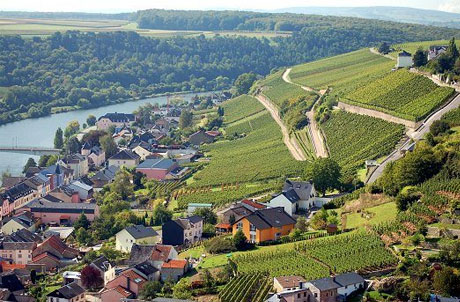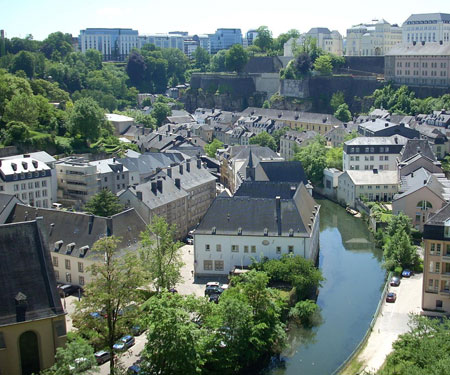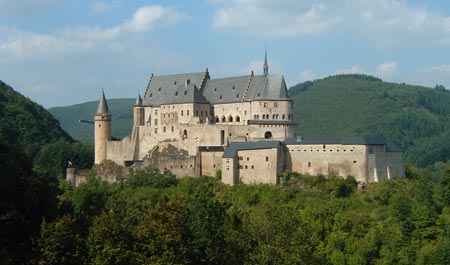Luxembourg
Country statistics

Total area: 998 sq miles (2,585 sq km)
Population (2010 est.): 497,538 (growth rate: 1.1%); birth rate: 11.7/1000; infant mortality rate: 4.5/1000; life expectancy: 79.5; density per sq km: 187
Capital City: Luxembourg
Monetary unit: Euro (formerly Luxembourg franc)
Languages: Luxermbourgish (national) French, German (both administrative)
Ethnicity/race: Celtic base (with French and German blend), Portuguese, Italian, Slavs (from Montenegro, Albania, and Kosovo), and European (guest and worker residents)
Religions: Roman Catholic 87%; Protestant, Jewish, Islamic 13% (2000)
Country introduction

Luxembourg, officially the Grand Duchy of Luxembourg, is a landlocked country in Western Europe, bordered by Belgium, France, and Germany. It has two principal regions: the Oesling in the north as part of the Ardennes massif, and the Gutland ("good country") in the south.
The country was established officially in the year 963. It turned into a Grand Duchy in 1815 when it was headed by a Grand Duke. Today Luxembourg is the only remaining Grand Duchy.
The terrain is mostly gently rolling lush highlands with broad, shallow valleys which merge from the mountainous Northern Ardennes with the Müllerthal's ancient forested landscape to the east where the vibrant town of Echternach is based, and steep slopes down to the south-east to the Moselle flood plains.
The culture

Most citizens are trilingual, speaking the Germanic national language of Luxembourgish in addition to French and German. Although its contributions to the arts are little known outside its borders, Luxembourg has a rich cultural history, especially in music, painting and photography.
The country has produced some internationally known artists, including the painters Théo Kerg, Joseph Kutter and Michel Majerus, as well as the photographer Edward Steichen. Steichen's The Family of Man exhibition is now permanently housed in Clervaux, and it has been placed on UNESCO's Memory of the World register.
Its evolving museums, concert halls, theatres and galleries testify to its citizens' growing appreciation of culture. There are a large number of museums in Luxembourg, which include the National Museum of Art and History, National Museum of Natural History and Grand Duke Jean Museum of Modern Art (Mudam). The National Museum of Military History (MNHM) in Diekirch is especially known for its representations of the Battle of the Bulge. The city of Luxembourg itself is on the UNESCO World Heritage List, on account of the historical importance of its fortifications.
Throughout the year a number of festivals are celebrated in Luxembourg, that reflect the Luxembourg culture. The two major festivals celebrated in the place are the Dancing Procession of Echternach and the Christmas celebration.
Attractions & landmarks

Luxembourg city can be explored on foot. Most of the sights are along the southern rim of the old town, where strollers will also find fantastic views and nice parks. The old town is based around two large pedestrian squares, Place d'Armes and Place Guillaume. The city's modern commercial center is across the Pétrusse Valley to the south, connected by two bridges, Pont Adolphe and Pont Passerelle. The Pétrusse and Alzette Rivers meet in the city centre.
Some landmarks to see while in Luxembourg city include the Grand Ducal Palace, which is the official residence of the Grand Duke. Visitors can also check out the beautiful Notre-Dame Cathedral built in late gothic architecture along with some Renaissance elements where it's elaborate interior houses some great works of art. Another important historical landmark include the Neumünster Abbey, which is a public meeting place and cultural centre of the capital.
North from Luxembourg city is the the picturesque and romantic Vianden commune where in the south-east snakes the Moselle Valley with its steep vineyards and riverside hamlets. In between all this are rolling farmlands dotted with pristine, pastel-toned houses and medieval hilltop castles. An example include the famous Vianden Castle, which is one of the largest fortified castles west of the Rhine. With origins dating from the 10th century, the castle was built in the Romanesque style from the 11th to 14th centuries.